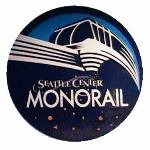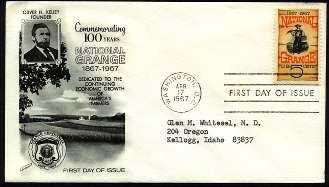
|
<<<< |

|
>>>> |

|

TRAINS ON U. S. STAMPS
and POSTAL STATIONERY
page 4b

Embossed postcard with train image - Limited Express |
4¢ SEATTLE WORLD'S FAIR - April 25, 1962
This stamp was issued to publicize the Seattle World's Fair of 1962, in keeping with a long tradition of USPS support of such endeavors. The train is the Monorail train "Century 21," which is still running today to carry tourists from downtown Seattle to the Space Needle observation tower. I rode it myself a couple of years ago, and despite the theme-park-like pointlessness of the experience - there were certainly no locals on board, and there are only two stops, one at each end - it was fun. Read about the Seattle Monorail's equipment HERE.
The FDC above is typical of all I have seen for this issue, Issuing commemoratives to advertise World's Fairs is a fine old postal tradition. It was first done in 1893, with a whopping 16-stamp set for the World's Columbian Exposition that was held in Chicago that year. Having set that precedent, the USPOD had a hard time refusing requests to commemorate similar events that followed, but soon learned to exercise a little more restraint - sets were issued in 1898 (Trans-Mississippi Expo, 9 stamps) , 1901 (Pan-American Expo,6 stamps) , 1904 (Louisiana Purchase Expo, 5 stamps) , 1907 (Jamestown Expo, 3 stamps) , 1909 (Alaska-Yukon Pacific Expo, 1 stamp) , and 1913 (Panama Pacific Expo, 4 stamps) . Large fairs went out of favor for a while then, and it was 1926 before another was held in the US - the Sesquicentennial Expo in Philadelphia in 1926 - one stamp for that one (two if you count Scott 630). Since then there have been 11 or 12 more fairs in the US, and most of them were commemorated with at least one stamp; but none of the recent ones has been a financial success, and the last one, twenty years ago now - New Orleans in 1984 - was a spectacular failure. I think all the theme parks have put large fairs out of business - who can compete with Disney World and its clones? Trains were vital in supplying visitors to all of the fairs through the mid-20th century, and four Fairs have had monorails - the first with one was the Centennial Expo in Philadelphia in 1876! But of all the stamps issued for Fairs, only this one and Scott 295, the 2-cent value from the 1901 Pan-American Expo set, have a rail theme. The stamp was designed by John Maass and William K Schrage, and engraved by C. A. Brooks and G. A. Payne. Over 147 million copies were printed, making it still relatively plentiful today, and worth no more than its face value. There are no known errors or significant varieties.
THE OLD MONORAIL
|
|||
NATIONAL GRANGE ISSUE - April 17, 1967
Issued to honor the one hundredth birthday of the National Grange,
What that description leaves out is perhaps the Grange's most important and far-reaching element, its political activities. By providing a forum for political discussions and political action, the Grange was able to help its members define a political agenda, and then to elect and influence public officials in ways that helped improve the situation of farmers. Today, with membership in 37 states and the District of Columbia, and with approximately 300,000 members, the National Grange is still very much alive. It has an extensive web site at http://www.nationalgrange.org/. This stamp was designed by Lee Pavao, modeled by R. J. Jones, and engraved by E. R. Felver and H. F. Sharpless. Over 121 million copies were printed, making it still plentiful today, and worth only its face value. There are no known major varieties. There is one printing error, "tagging omitted", with a 1997 catalog value of $3.50 per stamp. In 1967 the USPOD was near the end of its transition to tagging of all stamps. USPOD experiments with phosphor tagging of stamps had started in 1963, and by 1966, most commemorative stamps were being released both tagged and untagged. Starting with this stamp, all commemoratives were released tagged only. So this stamp has a special place as a "first". As with many of the stamps in that period, some got out with no tagging - called a "tagging omitted error". These are not plentiful, but since the error is not visible without a UV lamp, the premium they command is relatively modest.
Not surprisingly, none of the FDCs I have seen for this stamp includes a train in the cachet - most show Oliver Kelley and a farm scene, like the one above, by Fleetwood - and the train's presence on the stamp may seem incidental; but in 1870 trains were vital to America's farmers, as distributors of both the machinery and supplies needed to operate farms, and the crops they produced, so I think that tiny train was meant to be more than scenery on the poster from which this stamp was derived. My web search for information about the National Grange yielded some interesting facts about ways its history relates both to the Postal Service and to the railroads. First, the Grange was instrumental in proposing and promoting Rural Free Delivery (RFD) in this country in the late 1890's. Second, the Grange's support was a key factor in the establishment of parcel post in 1912. Third, the often greedy, unscrupulous ways railroads exercised their monopolies on transport of farm goods led farmers to be instrumental in getting the government to regulate them. Initially the Grange was responsible for the enactment of state-level laws lowering freight rates and establishing state railroad commissions to regulate railroads and other public utilities. The battle that ensued led to the creation in 1887 of the Interstate Commerce Commission, and the eventual Federal regulation of railroads.
Sources: |
||||
US TRAINS
|
Send feedback to the webmaster: CLICK HERE
Revised -- 11/18/2004




